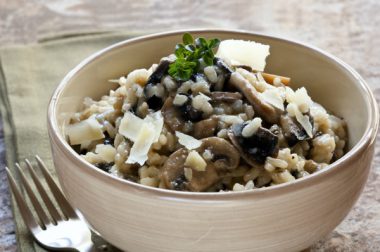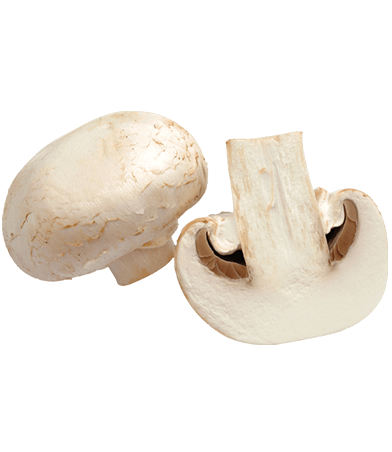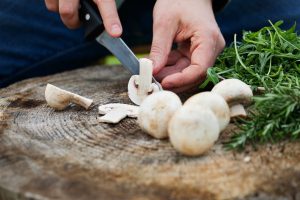Recipes we love
See all recipesCake with mushrooms, corn and cheese
This recipe contains vitamins and minerals, especially vitamin B9 which contributes to the growth of...
Stuffed mushrooms
An excellent way of starting a meal, combining vegetables and cheese, the two food groups that are m...
Chicken-liver stuffed mushrooms
If you are in a rush, opt for frozen spinach and follow the recipe, do not defrost the spinach....
Health
benefits
Button mushrooms are:
- a source of vitamin B9 (for cellular renewal, particularly important for pregnant women for fetal development, for growing children, and for convalescents).
- a source of vitamin B2 (for energy, the nervous system, red blood cells, and skin and eye health)
- a source of vitamin B3 (for energy, the nervous system, and skin health)
- a source of vitamin B5 (for energy, cognitive performance, and vitamin D synthesis)
- a source of potassium (for the nervous system, muscular function, and blood pressure)
Button mushrooms also contain:
- copper
- selenium
- a vitamin D precursor, ergosterol. That compound is transformed into vitamin D in the body. The ergosterol content varies according to the variety: wild mushrooms are thought to contain more than domesticated mushrooms.
Nutritional
composition
When is the right time to eat them?
All year.
The button (or white) mushroom is available year-round.
Vegetable patch
or urban balcony?
Button mushrooms thrive in damp, fresh, peat-based soil and grow in the dark.
To learn everything you need to know about growing mushrooms, read the page on growing advice.
Choosing and storing button mushrooms
Choose your button mushrooms well:
- Choose smooth mushrooms with a uniform color and no spots
- The cap should be firm in texture and firmly attached.
Properly store your mushrooms:
- Mushrooms are fragile, so eat them soon after purchasing!
- In the refrigerator: Store them for no more than three to four days in their original packaging, in the vegetable drawer, and keep them far from strong-smelling foods.
- Avoid freezing them: Home freezers work too slowly, damaging them quickly so that they lose a lot of water and flavor when you cook them.
Tips
and tricks
How to prepare mushrooms
Raw: Wipe them lightly with a damp cloth or quickly rinse them under clean water. Remove muddy parts and the stem, if it is dry. There is no need to peel them. Do not allow them to soak in water, because they could absorb large quantities of the liquid and lose their entire flavor!
Cooked: Button mushrooms must be cooked quickly so they do not lose their flavor and texture. Cook for around ten minutes on the stovetop or in the oven to sear and brown the mushrooms without drying them out. Do not add too much fat, because mushrooms act as sponges.
Recommendation to prevent mushrooms from turning brown: Sprinkle raw mushroom slices with lemon (lightly, otherwise they will ‘cook’!).
Mushrooms go well with…
Button mushrooms are truly a pleasure to cook, because they make a harmonious match with many other ingredients. They go very well with poultry, pork, veal, aromatic herbs (thyme, laurel, and parsley), spices (pepper, cumin, and paprika), cream, shallots, pasta, and pizza.
Portobello mushrooms (open mushrooms with wide caps) are delicious grilled and incorporated into dishes with sauces.
Anti-waste tip: Use the stems! If you are using your mushrooms to make a salad, a stuffing, or a sauté, don’t throw away the stems. They can be used later to cook delicious soups or purées.
Can everyone eat them?
Young children
Delicious and neutral-flavored, mushrooms are well-liked by children, who can eat them starting at eight months. Mushrooms must be well-cooked and mixed in with a sauce or other vegetables. You can give a child mushroom pieces between ten and twelve months.
And everyone else
Mushrooms can be eaten by people of all ages, supplying them with many vitamins in a fairly low-calorie food.
In case of digestive discomfort, mushroom consumption should be monitored, as they can cause flatulence and accelerated bowel movements.
See plenty of other tips for encouraging children to eat vegetables

Where do they come from?
Origins
Button mushrooms are grown throughout the world, including in North America, South America, Australia, New Zealand, and Europe (the Netherlands, Italy, France, and Poland). However, China is the number one producer in the world.
Varieties
While there are many types of mushrooms, the white mushroom, often called the button mushroom, is the most cultivated and consumed. There is also a brown variety of the button mushroom (sometimes called the ‘cremini’ or simply the ‘brown mushroom’), of which the portobello is one of the most popular varieties in the United States. It is distinguished by its large size and unique flavor, with a particularly defined scent that is reminiscent of that of wild mushrooms.



 Onions
Onions  Fava beans
Fava beans  Vegetable garden: growing spinach
Vegetable garden: growing spinach 










